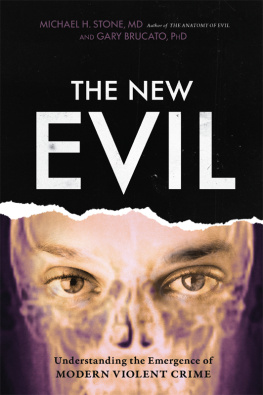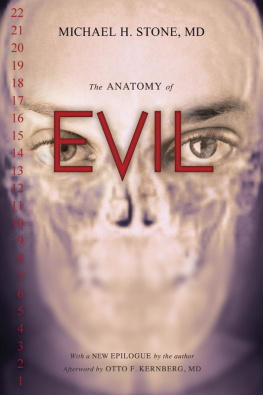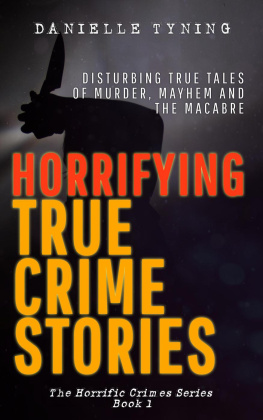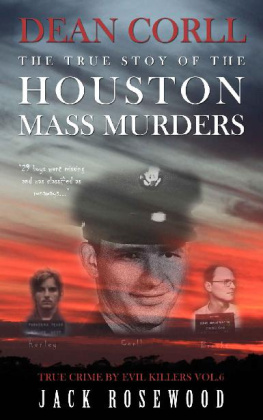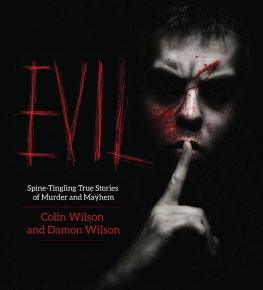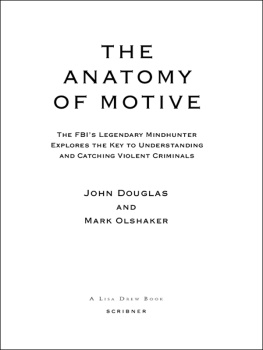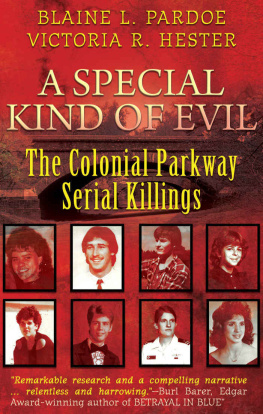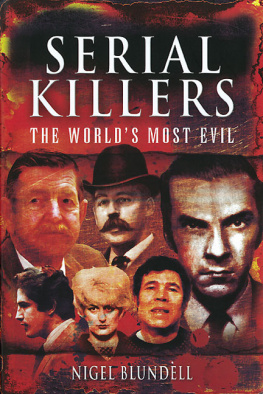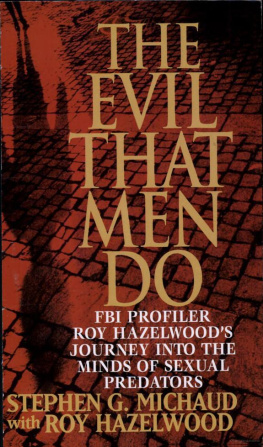
Dr. Michael Stone:
The acknowledgments section is the one happy area of a book otherwise devoted to mankind's darkest sidethe topic of evil. Here, I have the opportunity to thank those who dwell on mankind's brightest side: the many goodthe many especially goodpeople who served as inspiration for my work in this area. To the prestigious journalist of the New York Times, Ben Carey, I am most indebted for his having featured my writing on evil in the paper's science section in 2005. It was his article that caught the attention of the Discovery Channel, whose staff then sent me around the country to interview prisoners who had committed serial killing, mass murder, torture, cannibalism, and other forms of violent crimes that the public and the legal community label unequivocally and unhesitatingly as evil. Getting to know those prisoners firsthand helped launch my earlier book on the subject, The Anatomy of Evil. Many of the persons featured in the book merited the diagnosis psychopathwhich, along with sadism, is at the far end of the spectrum of abnormal personality. I learned about the nature of psychopathy from the foremost author on the subject, Dr. Robert Hare, whom I had gotten to know during my years in forensic psychiatry. As to my knowledge about personality disorders in general, I have benefited greatly from my colleagues in the United States, especially from Drs. Otto Kernberg, John Gunderson, Thomas McGlashan, Theodore Millon, Adrian Raine, and Bessel Van der Kolk. When I began to concentrate on forensic psychiatry, I had many teachers, from many countries. Among them: Drs. Reid Meloy, Katherine Ramsland, Paul Ciolino in the United States; from Canada, Drs. John Livesley, Marnie Rice, Christopher Perry; from England, Drs. Jeremy Coid, Sheila Hodgins, Conor Duggan; and from Scotland, Dr. David Cooke, who, with his colleagues in Glasgow, has developed another important measure of psychopathy. I owe debts of gratitude to many on the European continent, including Drs. Wolfgang Berner, Norbert Nedopil, Maya Krischer, Friedemann Pfffelin, Horst Kchele, and Thomas Bronisch from Germany; from the Netherlands, Drs. Henk-Jan Dalewijk, Thomas Rinne, and Hjalmar van Marle; from Switzerland, Drs. Jules Angst, Gerhard Dammann, and Luc Ciompi; from Sweden, Drs. Maria stberg and Kristina Hillgren; from Norway, Drs. Bjrn stberg and Alv Dahl; from Denmark, Drs. Tove Aarkrog, Eric Simonsen, and Fini Schulsinger; Dr. Mikhail Reshetnikov in Russia, who enlightened me about serial killer Andrei Chikatilo; Drs. Mario Iannucci and Sergio Dazzi in Italy; Dr. Jos Carrasco-Perez in Spain; Drs. Winfred Huber and Charles Hershkowitz in Belbium; and Dr. Jean Bergeret in France. Fruitful exchanges on personality disorders, including those relevant to forensics and the topic of evil, came also from colleagues in more far-flung places: Drs. Paul Mullen and Alan Unwin in Australia; Drs. Tsuyoshi Ishii and Yutaka Ono in Japan; Drs. Chantima Ongkosit and Sritham Thanaphum in Thailand; Dr. Xiao Ze-Ping in China; Drs. Michael Bond and Patrick Leung in Hong Kong; and Dr. Vedat ar in Turkey; Dr. Francisco Vallejo in Ecuador; Dr. Hilda Morana, with whom I visited imprisoned serial killers, in Brazil; Drs. Nestor Koldobsky, Jorge Folino, and Javier Didia-Attas in Argentina; Dr. Andres Heerlein in Chile; and in Mexico, Dr. Manuel Esparza, who introduced me to the advanced forensic laboratory in Ciudad Juarez.
People often ask me whether my thirty-five years as a combined psychoanalyst and forensic psychiatrist, part of which has been devoted to the study of violent crime and cases we tend to regard as evil, have not left me soured on the human race and a bit depressed. No. Because I have had the good fortune to be surrounded by family, friends, and colleagues who embody the good in our specieswho, fortunately, vastly outnumber the persons we regard as evil. And most of all, my wife Beth, whose beauty, both spiritual and physical, serve as a constantand close to homereminder of not just the good, but the best, our species has to offer. Thanks to my friends and colleagues, and most of all to her, I have been able to view evil as something fascinating and dramatic, yet distantsomething out there and far away, as though viewed from a different planet. Dr. Brucato and I of course hope that our book about what we regard as the new eviland the coarsening of our culture in the past half centurycan stimulate those in positions of power to effect salutary changes in our culture so that evil, while perhaps not eradicated, becomes a raritya topic more for historians, rather than for the majority of good persons who must otherwise remain on guard against those who would do evil.
It would take more words than our space permits to express my gratitude to my coauthor, Dr. Gary Brucato. Among his many contributions: a sharpening of the definitions of the Gradations of Evil scale, enabling others to better understand the various distinctions, and more readily to agree with the appropriate spot on the scale where any given offender would belong. Dr. Brucato dug more deeply into the lives of many of the arch criminals, especially the men who committed serial sexual homicide, than I was able to do. The result: we know more chilling details about many of these men, making the reader more certain than ever that the rape, torture, and murders of which these men were guilty would indeed evoke the reaction of evil! Dr. Brucato was also able to gain access to a large collection of letters and artwork (much of the latter very disturbing) by dozens of notorious killers. The resulting illustrations in the book make vivid how they bear out what we mean when we use the word evil. The book brings alive the old adage two heads are better than onethe more so when one of the heads is that of Dr. Brucato.
Dr. Gary Brucato:
The New Evil represents, for me, the culmination of two decades of studying, evaluating, treating, and contemplating severe psychopathology and violence in my training, clinical work, and research at six New York Citybased hospitals, as well as my professional and volunteer work with forensic psychiatric patients and incarcerated individuals. Throughout the course of my career, I have had many brilliant and selfless teachers. I am grateful for my years at Cathedral Preparatory Seminary, where I learned the joy of helping others, including prisoners and the mentally ill. It was also there that I was first introduced to the writings of Sir Arthur Conan Doyle, which taught me to pay attention to motive and small details when considering cases of violent crime, as well as the work of Soren Kierkegaard and Venerable Fulton J. Sheen, who strongly influenced my thinking regarding morality and evil. I am grateful to my mentors, Dr. John D. Hogan at St. John's University, and, at the New School for Social Research, Drs. David Shapiro, Herbert Schlesinger, Marcel Kinsbourne, McWelling Todman, Jeremy Safran, and especially forensic psychologist Dr. Ali Khadivi, with whom I worked for nearly two years at Bronx Lebanon Hospital Center, training in the assessment and treatment of serious psychiatric illness and violent behaviors. I am indebted to Dr. Albert Dreisinger, who taught me to conduct psychological evaluations for legal purposes; Dr. Thomas M. Pabon, who, on the Women's Forensic Unit at Mount Sinai Services / Elmhurst Hospital Center, oversaw my assessments and treatment of numerous persons who had committed unspeakable crimes; Dr. Barbara Cornblatt of the Zucker Hillside Hospital, who introduced me to the field of early psychotic illness, in which I have now worked for over a decade; and to those who helped me to become involved in conducting psychological and risk evaluations for the various colleges in the City University of New York (CUNY) system, especially Ryan Camire.
Next page
